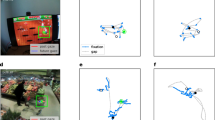Summary
Smooth pursuit eye movements have been described as resulting from the tracking of self-moved targets in total darkness. This study investigated the nature of the signal responsible for the release of smooth pursuit in this particular situation.
Simultaneous monitoring of eye and hand positions shows that in total darkness smooth pursuit can only be released if the imagined target is either passively or actively moved by the subject's hand. An ischaemic block applied at the level of the biceps allowed us to selectively remove the afferent signal preferentially to the efferent copy in tasks involving eye tracking of an imaginary target actively or passively moved. The results show that an afferent signal was necessary and sufficient to release smooth pursuit, whereas the efferent copy alone could not trigger smooth pursuit. However, the efferent copy could play an important role in the phase relationship (prediction) between eye and finger events and in the activation of the concomitantly active saccadic system.
Analysis of the eye movement characteristics, in various non-visually guided, load-affected situations, suggested that the main input to the smooth pursuit system was derived, in a non-graded way, from the position detector activation of the target-moving structure.
Similar content being viewed by others
References
Brindley, G.S., Merton, P.A.: The absence of position sense in the human eye. J. Physiol. (Lond.) 153, 127–130 (1960)
Browne, K., Lee, J., Ring, P.A.: The sensation of passive movement at the metatarso-phalangeal joint of the great toe in man. J. Physiol. (Lond.) 126, 448–456 (1954)
Clark, F.J., Burgess, P.R.: Slowly adapting receptors in cat knee joint: can they signal joint angle? J. Neurophysiol. 38, 1448–1463 (1975)
Deckert, G.H.: Pursuit eye movements in the absence of a moving stimulus. Science 143, 1192–1193 (1964)
Evarts, E.V.: Pyramidal tract activity associated with a conditioned hand movement in Monkey. J. Neurophysiol. 29, 1011–1027 (1966)
Fuchs, A.F.: Saccadic and smooth pursuit eye movements in the monkey. J. Physiol. (Lond.) 191, 609–631 (1967)
Gauthier, G.M.: Bio-engineering studies of cerebellar influences on oculomotor control. Ph. D. Thesis. University of Illinois, Chicago 1970
Gauthier, G.M.:Poursuite oculaire et porsuite manuelle en l'absence de cible. J. Physiol. (Paris) 69, 252a (1974)
Gauthier, G.M., Volle, M.: Two dimensional eye movement monitor, for clinical and laboratory recordings. Electroenceph. clin. Neurophysiol. 39, 285–291 (1975)
Goodwin, G.M., McCloskey, D.I., Matthews, P.B.C.: The contribution of muscle afferents to kinaesthesia shown by vibration induced illusions of movement and by the effects of paralysing joint afferents. Brain 95, 705–748 (1972)
Granit, R.: Demand and accomplishment in voluntary movement. In: Control of posture and locomotion, pp. 3–18. (Eds. R.B. Stein et al.). New York-London: Plenum Press 1973
Hagbarth, K.E., Vallbo, Å.B.: Discharge characteristics of human muscular afferents during muscle stretch and contraction. Exp. Neurol. 22, 674–694 (1968)
Luschei, E., Saslow, C., Glickstein, M.: Muscle potentials in reaction time. Exp. Neurol. 18, 429–442 (1967)
Matthews, P.B.C., Simmonds, A.: Sensations of finger movement elicited by pulling upon fexor tendons in man. J. Physiol. (Lond.) 239, 27 (1974)
Miller, J.M., Glickstein, M.: Neural circuits involved in visual motor reaction time in monkeys. J. Neurophysiol. 30, 399–414 (1967)
Noordeng, K. von, Mackensen, G.: Pursuit movements of normal and amblyopic eyes.I. Physiology of pursuit movements. Amer. J. Ophthal. 53, 325–336 (1962)
Riggs, L.A., Tulunay, S.U.: Visual effects of varying the extent of compensation for eye movements. J. Opt. Soc. Amer. 49, 741–745 (1959)
Robinson, D.A.: The mechanics of human smooth pursuit eye movement. J. Physiol. (Lond.) 180, 569–591 (1965)
Sherrington, C.S.: Observations on the sensual role of the proprioceptive nerve-supply of the extrinsic ocular muscles. Brain 41, 332–343 (1918)
Skavenski, A.A.: Inflow as a source of extraretinal eye position information. Vision Res. 12, 221–229 (1972)
Skavenski, A.A., Steinman, R.M.: Control of eye position in the dark. Vision Res. 10, 193–203 (1970)
Stark, L.: Neurological control systems.Studies in Bioengineering. New York: Plenum Press 1968
Stark, L., Vossius, G., Young, L.R.: Predictive control of eye tracking movements. IRE transactions on human factors in electronics. HFE 3, 52–57 (1962)
Steinbach, M.J.: Eye tracking of self-moved targets: the role of afference. J. exp. Psychol. 82, 366–376 (1969)
Steinbach, M.J., Held, R.: Eye tracking of observer-generated target movements. Science 161, 187–188 (1968)
Steinbach, M.J., Pearce, D.G.: Release of pursuit eye movements using after-images. Vision Res. 12, 1307–1311 (1972)
Vaughan, H.G. Jr., Costa, L.D.: Analysis of electro-encephalographic correlates of human sensori-motor process. Electroenceph. clin. Neurophysiol. 24, 281–294 (1968)
Westheimer, G.: Eye movement responses to a horizontally moving visual stimulus. A.M.A. Arch. Ophthal. 52, 932–941 (1954)
Zuber, B.L.: Sinusoidal eye movements from brain stem stimulation in the cat. Vision Res. 8, 1073–1079 (1968)
Author information
Authors and Affiliations
Rights and permissions
About this article
Cite this article
Gauthier, G.M., Hofferer, J.M. Eye tracking of self-moved targets in the absence of vision. Exp Brain Res 26, 121–139 (1976). https://doi.org/10.1007/BF00238277
Received:
Accepted:
Issue Date:
DOI: https://doi.org/10.1007/BF00238277




